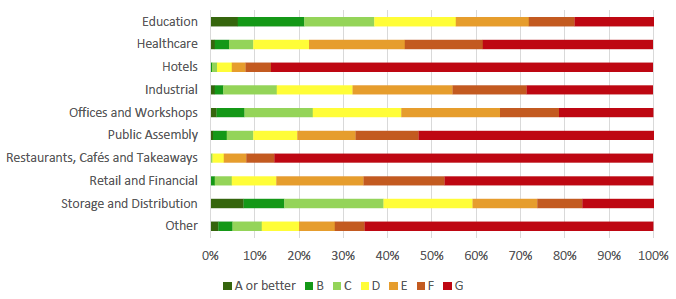Scotland's non-domestic energy efficiency baseline: report
This document outlines the energy efficiency of Scotland's non-domestic buildings with projections based on energy performance certificate data.
Current EPC banding
Figure 3 shows that it is estimated almost three in four of all non-domestic premises have a current EPC band of E or worse with 5 percent banded B or better.
Figure 3: Non-domestic premises by current EPC band

EPC bands present the calculated greenhouse gas emissions for a building on a scale from A to G. The underlying rating therefore reflects the energy efficiency of building elements (e.g. building fabric), the types of fuel used and heating, lighting and ventilation demand standardised by a combination of building type and activity. It can therefore vary considerably both within and between building types. This results in potential issues with using the current EPC band to monitor improvements in non-domestic energy efficiency over time. For example, even if the physical characteristics of a building do not change, the building's current EPC band can shift due to changes in the building's assumed use.
Figure 4 shows 86 per cent of hotels and 85 per cent of restaurants, cafés and takeaways are classed as band G, likely because the EPC model assigns a greater level of energy use to the activities associated with those building types. This is likely to reflect such buildings being in use throughout the day and being heated to comparatively high temperatures. Only 16 per cent of storage and distribution premises and 18 per cent of educational premises lie in the same band. This may result from assumptions that unlike hotels and restaurants, schools are not used for a full working day, at the weekend or during holidays and similarly that warehouses and stores are less energy intensive and are heated to a lower temperature than other buildings.
17 per cent of storage and distribution premises and 21 per cent of educational premises are banded B or better compared to just 3.5 per cent across all other non-domestic building types.
Figure 4: Non-domestic building types by current EPC band

Contact
Email: Mark Nightingale
There is a problem
Thanks for your feedback